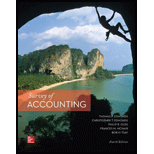
Concept explainers
a.
Calculate the
a.
Explanation of Solution
Straight-line Depreciation:
Under the straight-line method of depreciation, the same amount of depreciation is allocated every year over the estimated useful life of an asset. The formula to calculate the depreciation cost of the asset using the residual value is shown as below:
Calculate the depreciation expense for each of the five years using straight-line depreciation:
| Date | Depreciable Cost (in $) | Depreciation Rate | Depreciation expense (in $) |
| (A) | (B) | ||
| Year 1 | 40,000 | 1/5 | 8,000 |
| Year 2 | 40,000 | 1/5 | 8,000 |
| Year 3 | 40,000 | 1/5 | 8,000 |
| Year 4 | 40,000 | 1/5 | 8,000 |
| Year 5 | 40,000 | 1/5 | 8,000 |
Table (1)
Calculate the depreciable cost:
Hence, the depreciation expense for each of the five years using straight-line depreciation is $8,000.
b.
Calculate the depreciation expense for each of the five years, assuming the use of double-declining-balance depreciation.
b.
Explanation of Solution
Double-declining-balance method:
It is an accelerated method of depreciation under which the depreciation declines in each successive year until the value of asset becomes zero. Under this method, the book value (original cost less
Calculate the depreciation expense for each of the five years using double-declining-balance depreciation:
| Date | Double-Declining-Balance Depreciation Rate | Book Value (Refer note) (in $) | Depreciation expense (in $) |
| (A) | (B) | ||
| Year 1 | 0.40 | 42,000 | 16,800 |
| Year 2 | 0.40 | 25,200 | 10,080 |
| Year 3 | 0.40 | 15,120 | 6,048 |
| Year 4 | 0.40 | 9,072 | 3,629 |
| Year 5 | 0.40 | 5,443 | 3,443 |
Table (2)
Note:
Book value:
The amount of acquisition cost of less accumulated depreciation as on a particular date is referred to as book value.
Formula for book value:
Accumulated depreciation:
The total amount of depreciation expense deducted, from the time asset acquired till date, as reported in the account as on a particular date, is referred to as accumulated depreciation.
Formula for accumulated depreciation:
Determine the depreciation rate applied each year.
Useful life = 5 years
Compute depreciation expense on Year 5:
Hence, the depreciation expense for each of the five years using double-declining-balance depreciation are $16,800, $10,080, $6,048, $3,629, and $3,443 respectively.
c.
Identify whether the choice of one depreciation method over another would produce a different amount of cash flow for any year and discuss its reason.
c.
Explanation of Solution
Statement of cash flows:
This statement reports all the cash transactions which are responsible for inflow and outflow of cash, and result of these transactions is reported as ending balance of cash at the end of reported period.
Cash flows from operating activities:
These refer to the cash received or cash paid in day-to-day operating activities of a company. In this direct method, cash flow from operating activities is computed by using all cash receipts and cash payments during the year.
Depreciation is a non-cash expense. It is added to net income while preparing the statement of cash flows under the indirect method. Due to this, the cash flow is not affected. However, there will be differences in the taxable income and the tax paid amount, when different depreciation methods are used for the tax purposes.
Hence, the choice of one depreciation method over another would produce a different amount of cash flow for the year.
d.
Compute the amount of gain or loss on sale of the steam press using each depreciation method.
d.
Explanation of Solution
Compute the amount of gain or loss on sale of the steam press using straight-line depreciation method.
Calculate book value of the steam press:
Calculate gain on sale of the steam press:
Compute the amount of gain or loss on sale of the steam press using double-declining-balance depreciation method.
Calculate book value of the steam press:
Calculate gain on sale of the steam press:
Hence, the amount of gain on sale of the steam press using straight-line depreciation method, and double-declining-balance depreciation method are $4,000, and $12,928 respectively.
Want to see more full solutions like this?
Chapter 6 Solutions
Loose-Leaf for Survey of Accounting

 AccountingAccountingISBN:9781337272094Author:WARREN, Carl S., Reeve, James M., Duchac, Jonathan E.Publisher:Cengage Learning,
AccountingAccountingISBN:9781337272094Author:WARREN, Carl S., Reeve, James M., Duchac, Jonathan E.Publisher:Cengage Learning, Accounting Information SystemsAccountingISBN:9781337619202Author:Hall, James A.Publisher:Cengage Learning,
Accounting Information SystemsAccountingISBN:9781337619202Author:Hall, James A.Publisher:Cengage Learning, Horngren's Cost Accounting: A Managerial Emphasis...AccountingISBN:9780134475585Author:Srikant M. Datar, Madhav V. RajanPublisher:PEARSON
Horngren's Cost Accounting: A Managerial Emphasis...AccountingISBN:9780134475585Author:Srikant M. Datar, Madhav V. RajanPublisher:PEARSON Intermediate AccountingAccountingISBN:9781259722660Author:J. David Spiceland, Mark W. Nelson, Wayne M ThomasPublisher:McGraw-Hill Education
Intermediate AccountingAccountingISBN:9781259722660Author:J. David Spiceland, Mark W. Nelson, Wayne M ThomasPublisher:McGraw-Hill Education Financial and Managerial AccountingAccountingISBN:9781259726705Author:John J Wild, Ken W. Shaw, Barbara Chiappetta Fundamental Accounting PrinciplesPublisher:McGraw-Hill Education
Financial and Managerial AccountingAccountingISBN:9781259726705Author:John J Wild, Ken W. Shaw, Barbara Chiappetta Fundamental Accounting PrinciplesPublisher:McGraw-Hill Education





